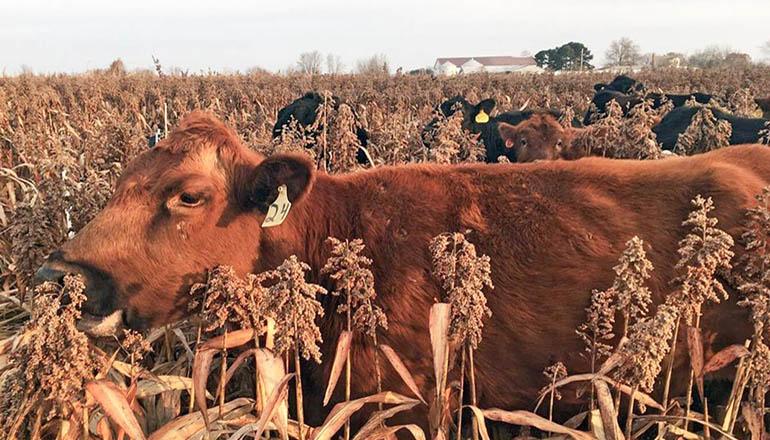(University Mo. Extension – Rusty Lee) – Missouri cattle producer John Chamberlin didn’t want to sell his cows when drought lingered, and hay supplies and forages dwindled last year.
With more than 600 head of Angus cows, Chamberlin turned to the internet for ideas. A video by the University of Missouri Extension on the benefits of grazing standing milo caught his attention.
He contacted the video’s creator, agronomist Rusty Lee from Montgomery County, to learn more. With assistance from Pettis County livestock specialist Gene Schmitz, they arranged a one-on-one Zoom training for Chamberlin at the MU Extension Center in Pettis County.
Despite the drought, Chamberlin successfully grew 115 acres of milo, yielding 80 to 90 bushels per acre. Lee and Schmitz visited Chamberlin’s farm in Henry County to evaluate his operation, assess the grain yield, and recommend strategies on carrying capacity and daily allocation area size.
Lee, an advocate for grazing standing milo, aimed to support Chamberlin in implementing this alternative feeding plan, proven effective for nearly a decade on Lee’s farm and others in east-central Missouri.
Chamberlin, facing a critical shortage of feed, decided to try the milo-based feeding strategy. “I have no feed,” he admitted. “If this milo thing doesn’t work, I’m going to have to sell cows.”
The strategy proved successful.
Milo’s drought resistance and affordability make it an excellent option, particularly in times of scarce and costly hay. It also addresses the challenge of making hay in May, the month with the highest rainfall. “You just sit there and watch your milo grow,” Lee remarked.
For optimal grain production, milo should be planted from May to early June, following winter wheat harvests, though a full growing season is recommended by Lee. Using poly wire electric fencing, producers can efficiently move cows daily to fresh paddocks, streamlining the feeding process.
Additionally, grazing on milo fields helps retain soil nutrients through the herd’s manure and urine, preventing the export of nutrients as grain.
Lee explains the economics of milo grazing, highlighting its efficiency and sustainability. With an average yield of 120 bushels per acre and a 25% feeding loss adjustment, the method supports a significant carrying capacity and extends the grazing period well into the winter, concluding around Valentine’s Day to avoid deterioration in stalk strength.
Chamberlin notes the ease and time efficiency of moving cows to new paddocks each day, emphasizing the benefits of rotational grazing with minimal infrastructure requirements. Despite some challenges like potential aphid infestations in southwestern Missouri, milo shows low disease pressure across most of the state.
Nutrient analysis of the forage consumed indicates adequate energy levels but necessitates protein supplementation. During extreme cold, Chamberlin provided additional hay to ensure the cows’ well-being.
Reflecting on the season, Chamberlin acknowledges the economic advantages of milo grazing over purchasing hay, emphasizing the cost savings and operational efficiencies. Planning to expand milo planting, Chamberlin views the practice as an integral part of his farming strategy.
Lee offers valuable tips for successful milo planting and grazing, ensuring the best outcomes for cattle producers.


